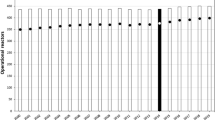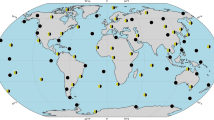Abstract
Atmospheric radioxenon levels are monitored worldwide by the Comprehensive Nuclear-Test-Ban Treaty Organisation (CTBTO) to detect emissions from nuclear explosions. This paper examines the global network that has been set up to take routine air samples and to determine the atmospheric radioxenon concentrations. It is hypothesised that the monitoring system aims at the detection and localisation of radioxenon releases. Both capabilities are dependent on background levels, explosive yields, leakage rates, transport time, choice of xenon isotope and number and locations of monitoring stations. For each parameter, the global capabilities to detect and localise emissions from nuclear explosions are analysed. Recommendations for the future of the background sources and the development of the monitoring system are derived.




Similar content being viewed by others
References
Auer, M., Kumberg, T., Sartorius, H., Wernsperger, B., & Schlosser, C. (2010). Ten years of development of equipment for measurement of atmospheric radioactive xenon for the verification of the CTBT. Pure and Applied Geophysics, 167, 471–486.
Bowyer, T., Kephart, R., Eslinger, P., Friese, J., Miley, H., & Saey, P. (2013). Maximum reasonable radioxenon releases from medical isotope production facilities and their effect on monitoring nuclear explosions. Journal of Environmental Radioactivity, 115, 192–200.
CTBTO Press Release (2013). Breakthrough in mitigating radioxenon emissions. https://www.ctbto.org/press-centre/press-releases/2013/breakthrough-in-mitigating-radioxenon-emissions/. Accessed Mar 2017.
Dahlman, O., Mykkeltveit, S., & Haak, H. (2009). Nuclear test ban, converting political visions to reality. Dordrecht: Springer Science + Business Media B.V.
De Geer, L.-E. (2001). Comprehensive Nuclear-Test-Ban Treaty: relevant radionuclides. Kerntechnik, 66(3), 113–120.
Eslinger, P., et al. (2016). International challenge to predict the impact of radioxenon releases from medical isotope production on a comprehensive nuclear test ban treaty sampling station. Journal of Environmental Radioactivity, 157, 41–51.
IAEA (2017). Power reactor information system (PRIS) by the IAEA. Available at http://www.iaea.org/programmes/a2/. Accessed Mar 2017.
Kalinowski, M. (2011). Characterisation of prompt and delayed atmospheric radioactivity releases from underground nuclear tests at Nevada as a function of release time. Journal of Environmental Radioactivity, 102, 824–836.
Kalinowski, M., & Tuma, M. (2009). Global radioxenon emission inventory based on nuclear power reactor reports. Journal of Environmental Radioactivity, 100, 58–70.
Kalinowski, M., et al. (2010). Discrimination of nuclear explosions against civilian sources based on atmospheric xenon isotopic activity ratios. Pure and Applied Geophysics, 167, 517–539.
Nichols, A. L., Aldama, D. L., & Verpelli, M. (2008). Handbook of nuclear data for safeguards: database extensions, IAEA International Nuclear Data Committee INDC (NDS)-0534.
Saey, P. (2007). Ultra-low-level measurements of argon, krypton and radioxenon for treaty verification purposes. ESARDA Bulletin, 36, 42–55.
Saey, P. (2009). The influence of radiopharmaceutical isotope production on the global radioxenon background. Journal of Environmental Radioactivity, 100, 396–406.
Saey, P., Bean, M., Becker, A., Coyne, J., d’Amours, R., De Geer, L.-E., et al. (2007). A long distance measurement of radioxenon in Yellowknife, Canada, in late October 2006. Geophysical Research Letters, 34, L20802.
Saha, S., et al. (2010). NCEP climate forecast system reanalysis (CFSR) 6-h products, January 1979–December 2010. Boulder: Research Data Archive at the National Center for Atmospheric Research Computational and Information Systems Laboratory.
Sameh, A.A. (2013). Production cycle for large scale fission Mo-99 separation by the processing of irradiated LEU uranium silicide fuel element targets. Science and Technology of Nuclear Installations, 2013, 704846.
Schoeppner, M., & Plastino, W. (2014). Determination of the global coverage of the IMS Xenon-133 component for the detection of nuclear explosions. Science & Global Security, 22(3), 209–234.
Schoeppner, M., Plastino, W., Hermanspahn, N., Hoffmann, E., Kalinowski, M., Orr, B., et al. (2013). Atmospheric transport modelling of time resolved 133Xe emissions from the isotope production facility ANSTO. Australia, Journal of Environmental Radioactivity, 126, 1–7.
Seibert, P. (1999). Inverse modelling of sulfur emissions in Europe based on trajectories. Inverse Methods in Global Biogeochemical Cycles AGU Geophysical Monograph, 114, 147–154.
Seibert, P., & Stohl, A. (2000). Inverse modelling of the ETEX-1 release with a Lagrangian particle model. In: Proceedings of 3rd GLOREAM Workshop, Sept. 1999, Ischia, 95–105.
Stohl, A., Forster, C., Frank, A., Seibert, P., & Wotawa, G. (2005). Technical note: the Lagrangian particle dispersion model FLEXPART version 6.2. Atmospheric Chemistry and Physics, 5, 2461–2474.
Stohl, A., Seibert, P., Wotawa, G., Arnold, D., Burkhart, J. F., Eckhardt, S., et al. (2011). Xenon-133 and caesium-137 releases into the atmosphere from the Fukushima Dai-ichi nuclear power plant: determination of the source term, atmospheric dispersion, and deposition. Atmospheric Chemistry Physics Discuss, 11, 28319–28394.
Wotawa, G., Becker, A., Kalinowski, M., Saey, P., Tuma, M., & Zähringer, M. (2010). Computation and analysis of the global distribution of the radioxenon isotope 133Xe based on emissions from nuclear power plants and radioisotope production facilities and its relevance for the verification of the Nuclear-Test-Ban Treaty. Pure and Applied Geophysics, 167, 541–557.
Author information
Authors and Affiliations
Corresponding author
Rights and permissions
About this article
Cite this article
Schoeppner, M. Performance Assessment of the CTBTO Noble Gas Network to Detect Nuclear Explosions. Pure Appl. Geophys. 174, 2161–2171 (2017). https://doi.org/10.1007/s00024-017-1541-y
Received:
Revised:
Accepted:
Published:
Issue Date:
DOI: https://doi.org/10.1007/s00024-017-1541-y




